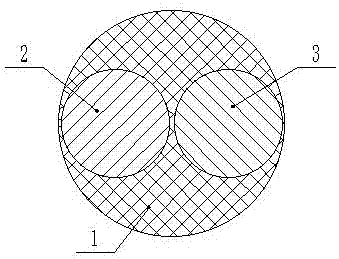Spiral particle stent
A helical, particle-based technology, applied in stents, X-ray/γ-ray/particle irradiation therapy, radiotherapy, etc., can solve the problems of complex operation and implantation, difficulty in binding particles, and easy fall-off, so as to inhibit tumor growth and carry Particles are convenient and easy to operate
- Summary
- Abstract
- Description
- Claims
- Application Information
AI Technical Summary
Problems solved by technology
Method used
Image
Examples
Embodiment Construction
[0018] Such as figure 1 The spiral particle support shown includes a tubular particle carrier 1, and the particle carrier 1 is provided with radiated particles. The particle carrier 1 is in a tightly arranged helical state in a natural state. When the two ends of the particle carrier 1 are pulled Adjacent helical coils are detached, the particle carrier 1 includes two lumens arranged side by side and closely fitted together, one of which is the guide wire lumen 2, the other lumen is the particle lumen 3, and the guide wire lumen 2 is It is not connected with the particle chamber 3, and the radiated particles are arranged in the particle chamber 3. When a supporting guide wire is arranged in the guide wire chamber 2, the particle carrier 1 is in an elongated state. In order to make the radiated particles closer to the tumor, the particle cavity 3 is located outside the guide wire cavity 2 . In order to scratch the surface of the particle carrier 1 on human tissue, the edges of...
PUM
 Login to View More
Login to View More Abstract
Description
Claims
Application Information
 Login to View More
Login to View More - R&D
- Intellectual Property
- Life Sciences
- Materials
- Tech Scout
- Unparalleled Data Quality
- Higher Quality Content
- 60% Fewer Hallucinations
Browse by: Latest US Patents, China's latest patents, Technical Efficacy Thesaurus, Application Domain, Technology Topic, Popular Technical Reports.
© 2025 PatSnap. All rights reserved.Legal|Privacy policy|Modern Slavery Act Transparency Statement|Sitemap|About US| Contact US: help@patsnap.com



